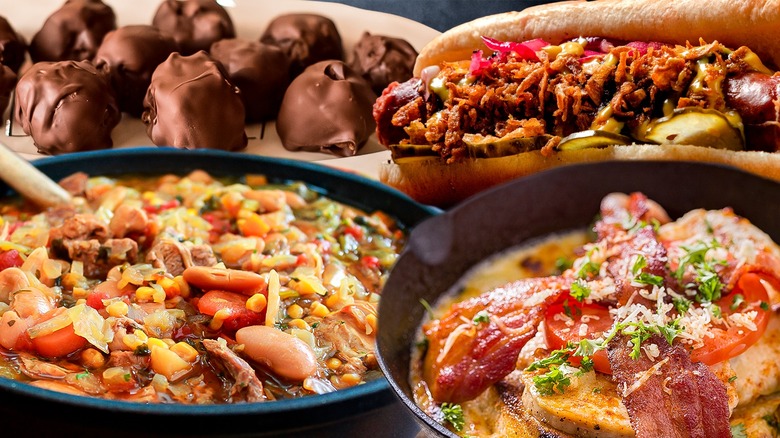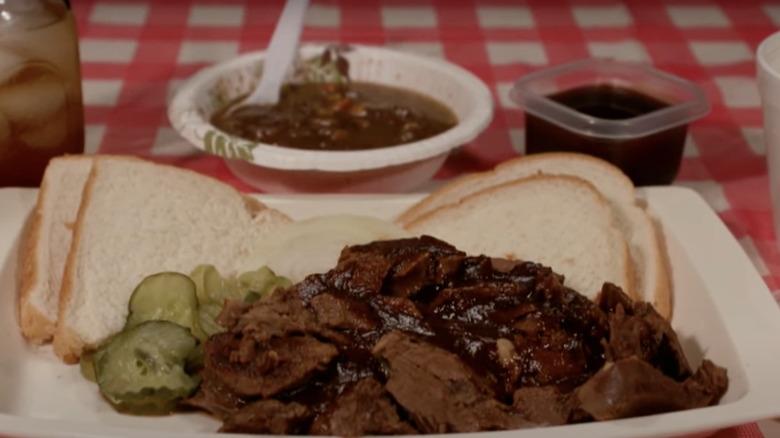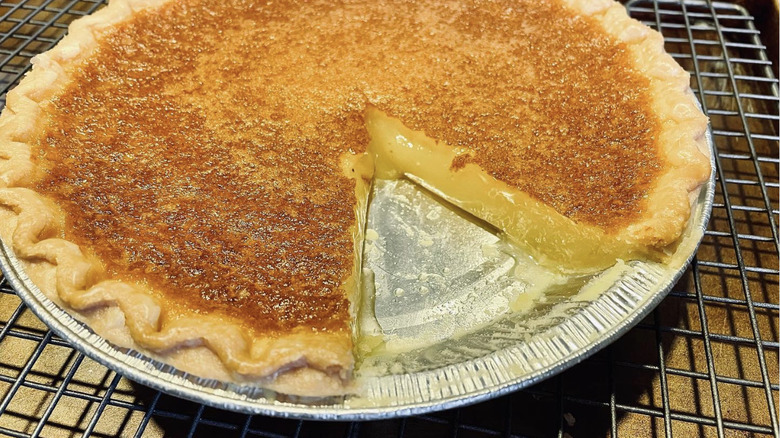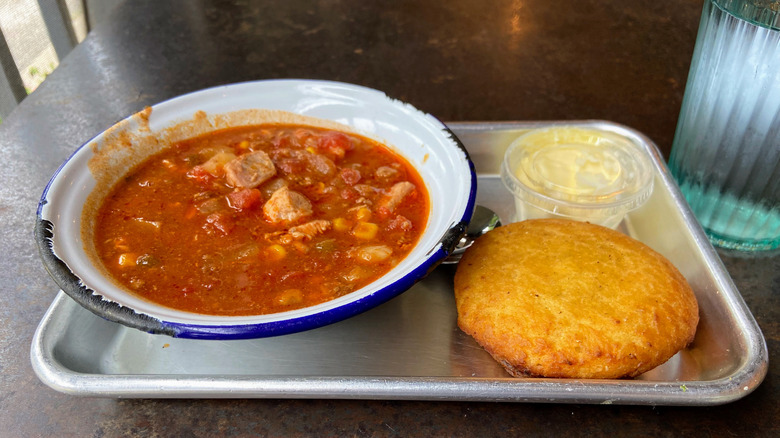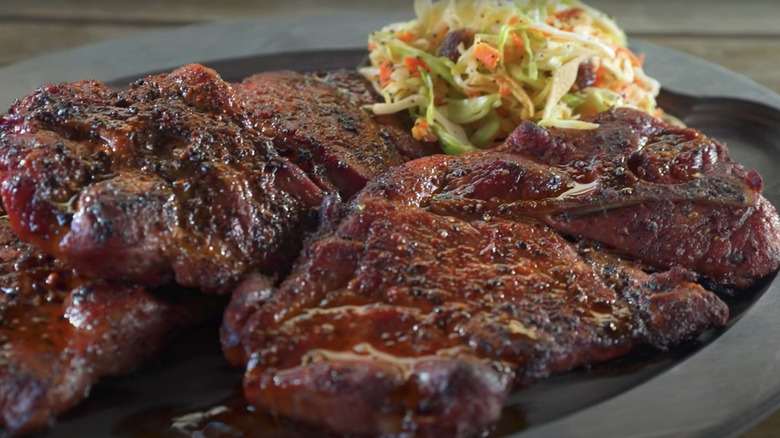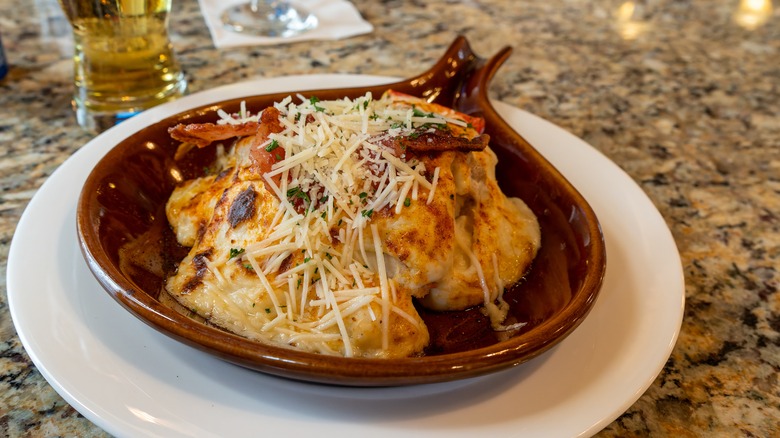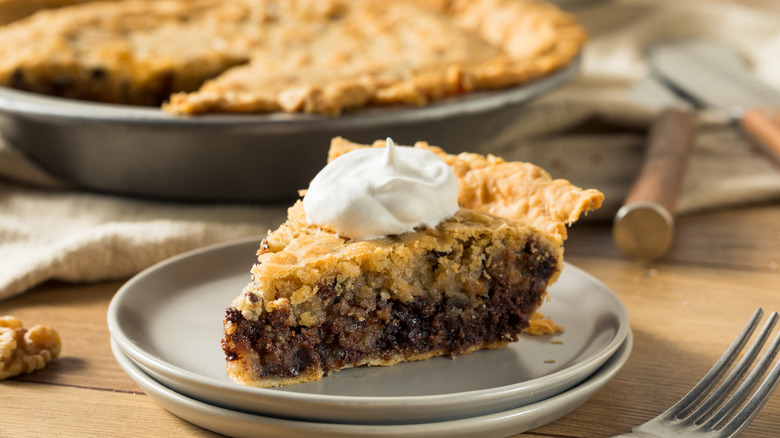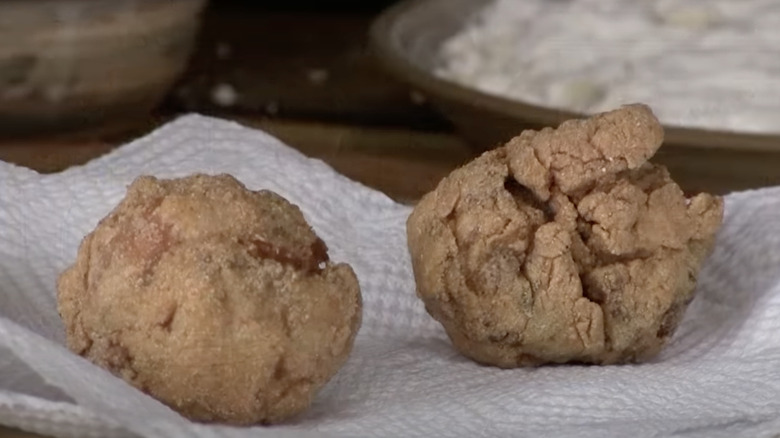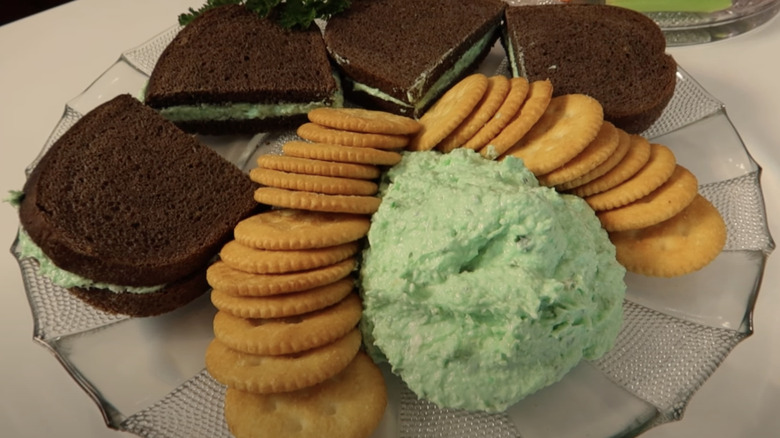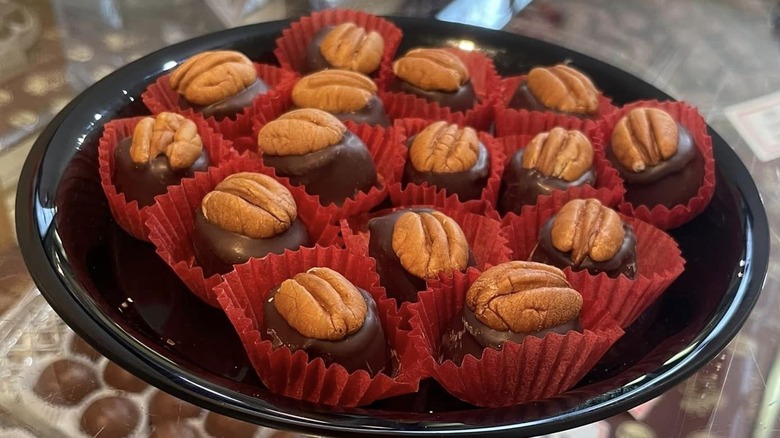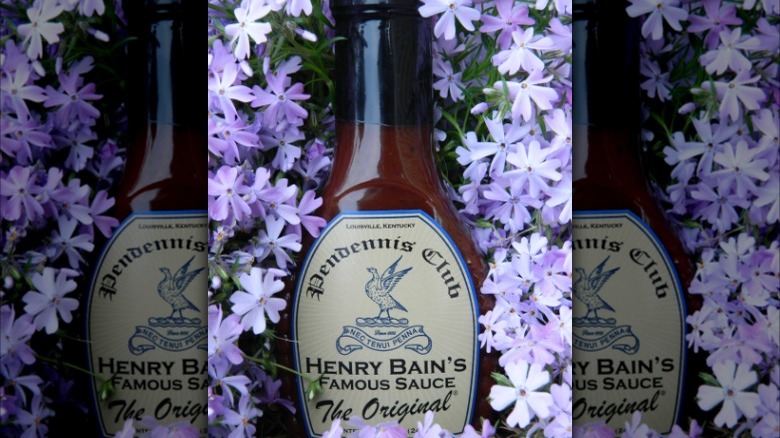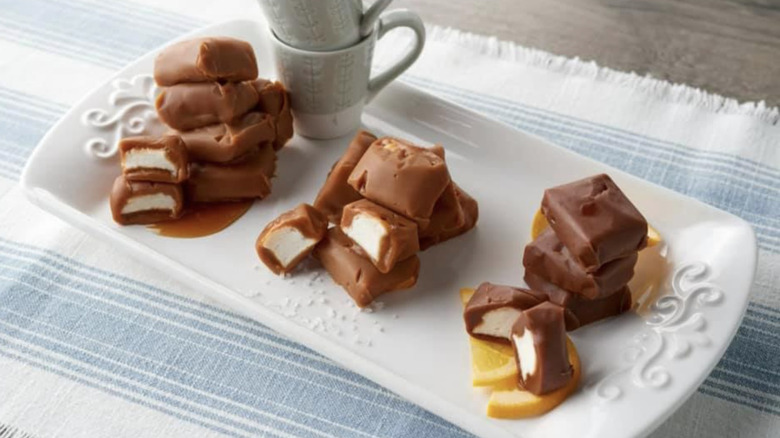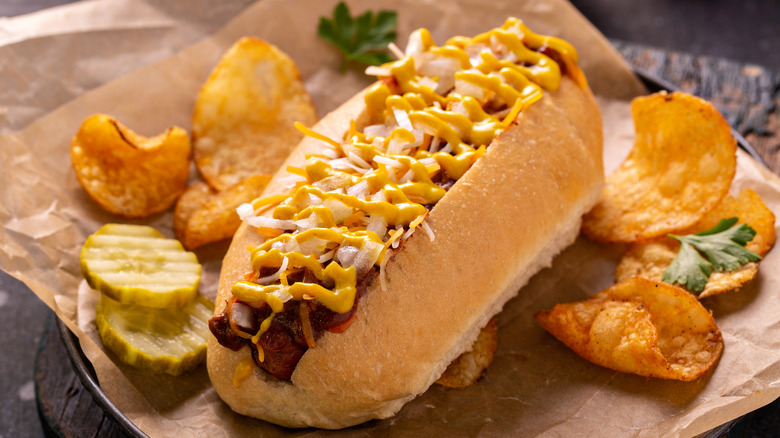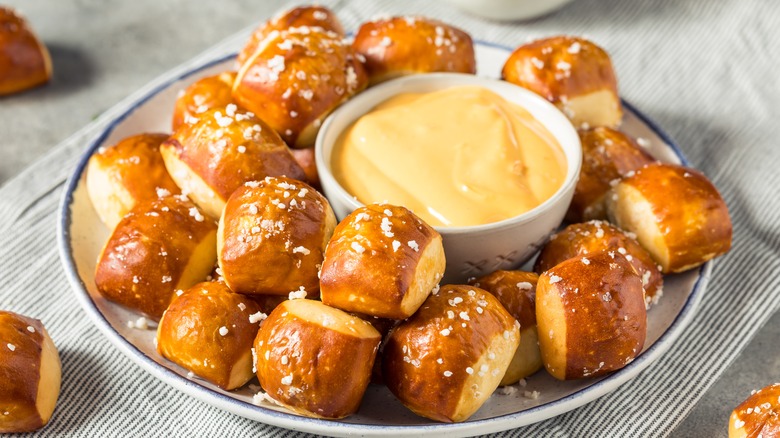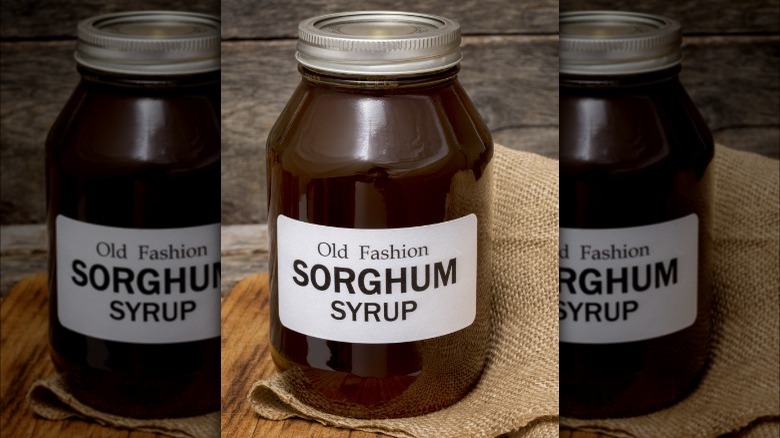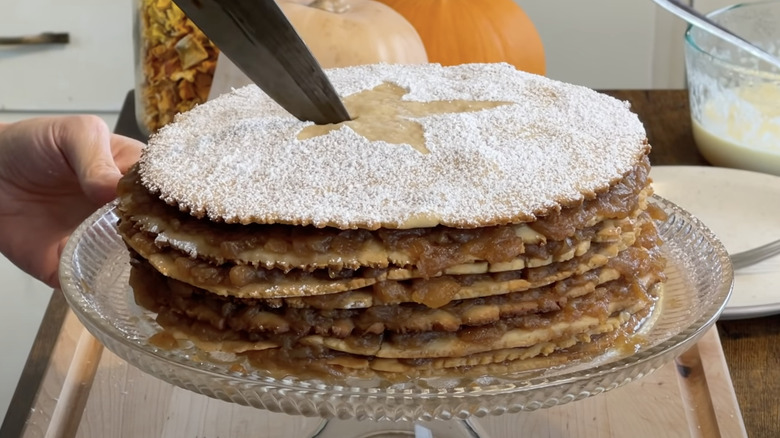15 Unique Kentucky Foods You Need To Try
Kentucky is famous for bourbon, which is completely understandable — the state is full of great bourbon distilleries. However, alcohol is far from the only culinary delight the Bluegrass State has to offer. Kentucky has a long history of producing excellent food in addition to the country's best whiskey. Of course, the first thing that comes to mind is KFC, which was born in the town of Corbin, Kentucky. But fried chicken is hardly unique to Kentucky — it's a specialty all over the South.
For this list, we dug deeper to find the special dishes that make Kentucky different from any other state in the Union. From urban specialties dreamed up by fancy chefs in Louisville to country classics cooked up by Appalachian miners, Kentucky has produced a wide range of signature foods. If you've never been to the state, we guarantee that you'll be drawing up travel plans to visit Kentucky after reading this article. You're going to want to try all of these mouth-watering dishes, many of which are still hard to find in the rest of the country.
Barbecue mutton
Trying to name all of America's regional barbecue styles is a nigh-impossible task — there are nearly as many different ways of smoking meat as there are pitmasters. In Kentucky alone, there are at least three major styles (though there is plenty more variation from town to town and county to county). Across Western Kentucky, pulled or chopped pork reigns, typically made with pork shoulder. Monroe County also cooks shoulder but slices it into thin pork chops before grilling (more on that later). Perhaps the most famous style of Kentucky barbecue, and the dish that no other state makes, is barbecue mutton.
Despite mutton's renown in Kentucky, only a small percentage of the state's barbecue places still serve the dish. Owensboro, in Daviess County, is the place to go for mutton barbecue. There is a historical reason for this: the area was a hotspot for wool production. While in modern times, most sheep are slaughtered young to make lamb, people in Daviess County would wait until their sheep were fully grown so they could harvest wool before slaughtering the animal. The tough, flavorful meat of the mature sheep was perfect for long, slow smoking.
Owensboro-style barbecue mutton is usually made with hickory-smoked shoulder meat basted with a spicy vinegar-based sauce that often contains Worcestershire. Once the meat is tender, it's sliced and served with more sauce.
Transparent pie
Transparent pie is a close cousin to other Southern pies like chess pie and pecan pie. Like those types of pie, it's filled with a custard that includes eggs and sugar, however, it's made with slightly different ingredients. While pecan pie is typically made with corn syrup (and pecans), transparent pie is sweetened with white sugar and contains no nuts. Chess pie often contains cornmeal, while transparent pie is thickened with white flour instead, and adds heavy whipping cream to the filling mixture. The pie filling is flavored simply with butter and vanilla.
Despite the name, transparent pie isn't perfectly see-through like the clear pumpkin pie that went viral a few years ago. It looks a lot like chess pie, with a golden-brown crust on top and a rich, yellow, creamy interior. Transparent pie was a product of the small farms of the Northern Kentucky River Region in the 1800s. Traditional pie filling ingredients could be scarce back then, which led to the creation of pie recipes that were made mostly with pantry staples like flour, sugar, and eggs. The recipe has come to be associated with Magee's Bakery, which has been selling transparent pie since the '30s.
Burgoo
If you're tired of eating barbecue mutton straight-up, it can also be mixed into a hearty stew called burgoo. Burgoo is a staple all over Kentucky, though, like mutton, it is perhaps best in Owensboro. It needn't necessarily contain mutton — in fact, it doesn't really have any standard ingredients. Burgoo is usually made with multiple (sometimes smoked) meats and vegetables simmered together for hours in a broth that's seasoned with barbecue sauce. Typical veggies include okra, corn, potatoes, tomatoes, and beans. This stew is traditionally simmered until the vegetables basically disintegrate.
Although burgoo's exact origins are hard to pin down, it's definitely a dish with a long history. The recipe dates back at least to the 1800s, and perhaps much earlier than that. Different origin stories claim that burgoo was invented by Native Americans or freed slaves. Wherever it came from, by the 1800s, the stew was a common sight at livestock auctions because it was a convenient way to feed a crowd. This association with farm animals eventually led to burgoo being served to the crowds at racetracks, and it remains a popular Kentucky Derby dish to this day.
Monroe County-style pork chops
We promised we'd talk about Monroe County-style barbecue eventually. The people who live in this region that shares a border with Tennessee call their local specialty "shoulder," but you'll likely see the dish referred to as "Monroe County-style pork chops" or "pork steaks" online. Whatever you call it, Monroe-style barbecue starts with a pork butt that's frozen to firm it up. It's then cut into thin (less than an inch) chops with an electric bandsaw. Some people might even say that Monroe County chops don't count as barbecue because the thin pieces of meat are grilled relatively quickly rather than being slow-smoked for hours. However, the traditional heat source, hickory coals, adds plenty of smoky barbecue flavor.
Other than smoke, the main flavoring component of this style of barbecue is a marinade or sauce made with vinegar, lard, butter, cayenne, and black pepper. This spicy, tart, fatty mixture may have originally been concocted by enslaved cooks living near Monroe County. Depending on how much sauce you add to your pork, it can range from pleasantly warm to tongue-meltingly hot. Coleslaw helps soothe the burn.
Hot Brown
Although you might guess that the Hot Brown sandwich's name simply describes its physical appearance (it is indeed both hot and brown), the dish is actually named after its place of origin: the ritzy Brown Hotel in Louisville. Legend holds that the Hot Brown was a product of late-night inspiration from the Brown Hotel's chef in the 1920s, Fred Schmidt. The hotel regularly welcomed over 1,200 guests at its elegant evening dances. Schmidt concocted the Hot Brown as a fancy way to feed these nighttime revelers.
If you ate a Hot Brown after a long night of drinking and dancing, you certainly wouldn't go to bed hungry. This decadent open-faced sandwich starts with a base of Texas toast topped with bacon and roast turkey, garnished with sliced tomato, and topped with Mornay sauce (basically a cheesy white gravy or bechamel). This whole mess is then broiled until it's, well, hot and brown, and topped with paprika and parsley.
Derby-Pie
While you can find many recipes called Kentucky Derby pie, there is only one Derby-Pie. The pie (which is trademarked) was invented by Walter and Leaudra Kern, along with their son George, in 1954. Its iconic name was chosen by drawing potential names from a hat. At the time, the Kerns managed a restaurant called the Melrose Inn. When they left the restaurant a few years later, they took their pie recipe with them and began baking pies to sell to the Melrose and other restaurants. Descendents of the Kerns still make Derby-Pie to this day, and if you're lucky enough to live in Kentucky you may be able to buy it at local grocery stores or restaurants.
If you're not a resident of the Bluegrass State, you can have Kern's Kitchen ship pies to you or attempt to make a copycat recipe at home (authenticity not guaranteed). Although the Kern's Derby-Pie formula is a closely-guarded secret, it appears to consist of a custard similar to transparent pie or pecan pie that's filled with chocolate chips and chopped walnuts.
Rolled oysters
A rolled oyster is essentially a hyper-local variation of a fried oyster that was invented in Louisville in the 19th century. Although oysters aren't a local Kentucky ingredient (the state is land-locked), the advance of railroad technology in the 1800s allowed fresh oysters to be transported to the state from the Chesapeake Bay. The availability of oysters led an Italian saloon proprietor in Louisville named Phillip Mazzoni to cook up the first rolled oysters to feed his hungry patrons.
Sadly, Mazzoni's, the restaurant that birthed the rolled oyster, shut its doors in 2008, but rolled oysters are still a fixture in Louisville's dining scene (though skyrocketing oyster prices have made it harder for restaurants to turn a profit serving them). The oysters are rolled in so much cracker meal or cornmeal before frying that the end product is more breading than seafood; the oyster typically bursts during the cooking process, leaving a briny, moist pocket in the middle of the cracker meal.
Benedictine
Don't confuse Kentucky Benedictine with the French herbal liqueur of the same name — they have nothing in common. Kentucky Benedictine is a dip or sandwich spread named after Jennie Benedict, a famous early 20th-century caterer, restaurateur, and cookbook author from Louisville. Benedict originally intended her eponymous spread as a filling for finger sandwiches. Her recipe mixed cream cheese with cucumber juice, onion juice, a touch of cayenne, and green food coloring.
Modern recipes sometimes omit the food coloring for a more natural look and use chopped cucumber and onion instead of juice to give the dip some texture. Benedictine can be bought pre-made from grocery stores in Kentucky and is a staple at gatherings. In addition to spreading it on crustless white bread to make sandwiches, you can also serve it in a bowl with crackers for dipping. For a special twist, you can try our Benedictine and bacon sandwich recipe, which is much heartier than the dainty finger sandwiches this spread is usually used for.
Bourbon balls
We may not be including bourbon on this list (it is, after all, not food), but there's a Kentucky confection that uses the Bluegrass State's most famous export as a flavoring ingredient: bourbon balls.
Bourbon balls were created by Ruth Hanley Booe, who founded Rebecca Ruth Candy in Frankfort, Kentucky in 1919 with her friend, Rebecca Gooch. By 1936, Ruth was running the company on her own and had yet to enjoy sustained success. A conversation she had at Frankfort's sesquicentennial celebration that year inspired her to create a bourbon-flavored candy. After two years of testing, she began selling her new bourbon balls, which became a runaway hit.
Rebecca Ruth's original recipe, which you can still buy today, uses an Evan Williams 100-proof bourbon-flavored cream center enrobed in dark chocolate and topped with a pecan. There's a completely different version of bourbon balls you can make at home that combines crushed vanilla wafers, nuts, corn syrup, and bourbon. You roll the cement-like bourbon mixture into balls that are then coated in powdered sugar.
Henry Bain's sauce
Henry Bain's sauce is named after the man who invented it. Mr. Bain worked at Louisville's Pendennis Club, a member's-only social club that was founded in 1881. He was one of the club's first employees and worked his way up from elevator boy to Maitre d'. The sauce that bears his name was created to accompany steaks and game meats and was a long closely-guarded secret of the club, but now you can buy the official version online or make a copycat recipe.
The sauce is a potent, sweet-savory-sour mixture that's a little reminiscent of British brown sauce. If you don't like to cover up the taste of your meat with powerful condiments, this is not the steak sauce for you. The recipe combines Worcestershire sauce, A.1., Heinz chili sauce, ketchup, chutney, hot sauce, and pickled walnuts. We can see how this intense mixture would provide a nice contrast to the gaminess of wild meats, but the idea of adding a ketchup-based sauce to steak feels sacrilegious to our modern palates.
Modjeskas
Modjeskas are a Kentucky candy with an even longer history than bourbon balls. They were created in 1883 by a French candymaker living in Louisville named Anton Busath. Busath was a big fan of Helena Modjeska, a Polish actress who performed in the McCauley Theater close to his candy shop. With Modjeska's blessing, he named his special caramel biscuits after the actress.
A Modjeska is a simple confection consisting of soft, chewy caramel with a marshmallow center. Although Busath's store closed in 1947 after a fire, the original recipe lives on at Muth's Candy, which opened in 1921. Anton Busath's son gave his father's recipe to Muth's, and it has become that shop's signature item and best-seller. Another confectioner, Bauer's Candies of Lawrenceville, Kentucky, also specializes in Modjeskas. While Bauer's may not have Busath's recipe, the store has actually been selling Modjeska's for longer than Muth's, as it began offering caramel biscuits in 1889.
Chili buns
What do you get when you make a chili dog without the dog? An Appalachian chili bun, of course. This sandwich is a specialty of the Appalachian South, particularly Eastern Kentucky. The dish came to prominence in the mid-20th century in the region's pool halls. Coal miners would gather in these establishments after a long day of work to hang out, drink beer, and shoot pool. Naturally, they'd get hungry, and the chili bun was a cheap and easy way for pool halls to keep their patrons fed. Eventually, the dish spread beyond the rowdy, male-dominated space of the pool hall and began being served in restaurants and diners.
A proper chili bun is an exercise in elegant simplicity. It consists of a steamed hot dog bun stuffed with thick, hearty chili and garnished with mustard and raw onions. You can't just use any kind of chili — the chili traditionally used in this dish has very little tomato and is made with all meat (no beans here). To make sure it's thick enough to make a good sandwich, it's sometimes thickened with crushed saltine crackers.
Beer cheese
Beer cheese may be a staple at breweries across the country these days, but it was born in Winchester, Kentucky — at least according to one version of the story. While this dip and spread may have roots in Germany or Wales, the modern version of the dish is Kentuckian. There's a theory that it originated in the 1800s in bars as a way for proprietors to make use of old, flat beer, but the most-repeated origin story is that Joe Allman created the recipe in the late '30s for his cousin John Allman's Winchester restaurant, the Driftwood Inn. The town of Winchester now holds an annual beer cheese festival.
Our Kentucky beer cheese recipe is a spicy, piquant picture of pureed sharp cheddar, blue cheese, butter, beer, Worcestershire, and spices. Like the original Winchester version, it's meant to be served cold as a spread, but plenty of restaurants also serve hot variants that have a texture more like nacho cheese sauce.
Sorghum
Sorghum is an ingredient that sets Kentucky apart from the rest of the U.S. While you're unlikely to find sorghum on the shelves of local grocery stores in most of the country, the ingredient is commonplace in the Bluegrass State, where it is used in dishes such as cornbread, biscuits, and even cocktails.
This crop is a grass grown as a cereal grain in much of the world. Its seeds can be cooked like rice, added to soups, or even popped like popcorn. Sorghum came to Kentucky from Africa through the Atlantic slave trade. In Kentucky, it's primarily grown for its syrup. Much like sugarcane, sorghum's stalks are filled with sweet juice that can be extracted and concentrated to make a molasses-like sweetener. It can replace honey or molasses in many dishes and is often used as a topper or ingredient for baked goods. Kentucky produces more sorghum syrup than any other state in the U.S.
Stack cake
Stack cake is a type of layer cake that has been popular in the Appalachian Mountain South for centuries. Sometimes it's known as Kentucky stack cake, but Tennessee claims the dish as well. Either way, the cake is basically the same whether you're cooking the Kentucky or Tennessee version. Those who say Kentucky is the birthplace of stack cake point to the story of James Harrod, who settled in Kentucky in 1774 and allegedly learned the recipe for the dish in his hometown in Pennsylvania.
Stack cake is made with a buttermilk cake batter sweetened with molasses or sorghum. The batter is baked into around six circular layers; traditionally these layers are baked one at a time in a skillet, sort of like pancakes, but there are modern methods that take less time. The layers are stacked with apple filling in between them. This filling is made with dried apples rehydrated with water, sweetened with brown sugar, and seasoned with spices like ginger and cinnamon.
